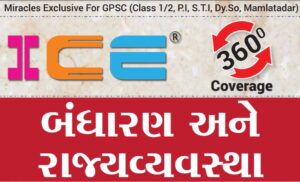Bharatiya Bandharan Ane Rajvyavstha India is a Sovereign Socialist Secular Democratic Republic with a Parliamentary form of government which is federal in structure with unitary features. There is a Council of Ministers with the Prime Minster as its head to advice the President who is the constitutional head of the country. Similarly in states there is a Council of Ministers with the Chief Minister as its head, who advices the Governor. This section provides insight of Indian governance and administration at the Central, state as well as local level. Information about the Constitution of India, Parliament and Legislature, Union administration, state, district and local administration is given.
Related Post : ICE Current Affairs | Download ICE MAGIC 52 (19-12-2021 to 25-12-2021)
India, also known as Bharat, is a Union of States. It is a Sovereign Socialist Secular Democratic Republic with a parliamentary system of government. The Republic is governed in terms of the Constitution of India which was adopted by the Constituent Assembly on 26th November, 1949 and came into force on 26th January, 1950. The Constitution provides for a Parliamentary form of government which is federal in structure with certain unitary features. The constitutional head of the Executive of the Union is the President.
Related Post : NMMS Exam Practice Book | NMMS Book PDF | NMMS Best Book Gujarati
Bharatiya Bandharan Ane Rajvyavstha
As per Article 79 of the Constitution of India, the council of the Parliament of the Union consists of the President and two Houses known as the Council of States (Rajya Sabha) and the House of the People (Lok Sabha). Article 74(1) of the Constitution provides that there shall be a Council of Ministers with the Prime Minister as its head to aid and advise the President, who shall exercise his/her functions in accordance to the advice. The real executive power is thus vested in the Council of Ministers with the Prime Minister as its head.
The Constitution of India came into force on 26th January, 1950. At the time of its adoption, the Constitution contained 395 Articles and 8 Schedules and was about 145,000 words long, making it the longest national Constitution to ever be adopted. Every Article in the Constitution was debated by the members of the Constituent Assembly, who sat for 11 sessions and 167 days to frame the Constitution, over a period of 2 years and 11 months.
Download Bharatiya Bandharan Ane Rajvyavstha PDF

Bharatiya Bandharan Ane Rajvyavstha
This section contains every Article in the amended Constitution of India (as of 2020), with its corresponding Article in the Draft Constitution of India, 1948. Each Article also contains a summary of the debates on that Article in the Constituent Assembly. The Articles are grouped into 22 different parts, which reflects how they are organized in the text of the Constitution of India, 1950
The Schedules to the Constitution, which are now 12 in number, elaborate on government policy or rules in relation to specific Articles of the Constitution. Each Schedule in this section is tagged with the corresponding Article(s) for ease of understanding. The fountain source of law in India is the Constitution which, in turn, gives due recognition to statutes, case law and customary law consistent with its dispensations. Statutes are enacted by Parliament, State Legislatures and Union Territory Legislatures. There is also a vast body of laws known as subordinate legislation in the form of rules, regulations as well as by-laws made by Central and State Governments and local authorities like Municipal Corporations, Municipalities, Gram Panchayats and other local bodies.
Bharatiya Bandharan Ane Rajvyavstha
This subordinate legislation is made under the authority conferred or delegated either by Parliament or State or Union Territory Legislature concerned. The decisions of the Supreme Court are binding on all Courts within the territory of India. As India is a land of diversities, local customs and conventions which are not against statute, morality, etc. are to a limited extent also recognised and taken into account by Courts while administering justice in certain spheres.
NOTE :
Every book or material used in this blog is placed Only For the purpose of education without taking any charge or making any money using this Materials. If you notice copyright,Please contact the following email [contact@shikshanjagat.net]
Related Post :
November Din Vishesh PDF | Useful For Competitive Exams

